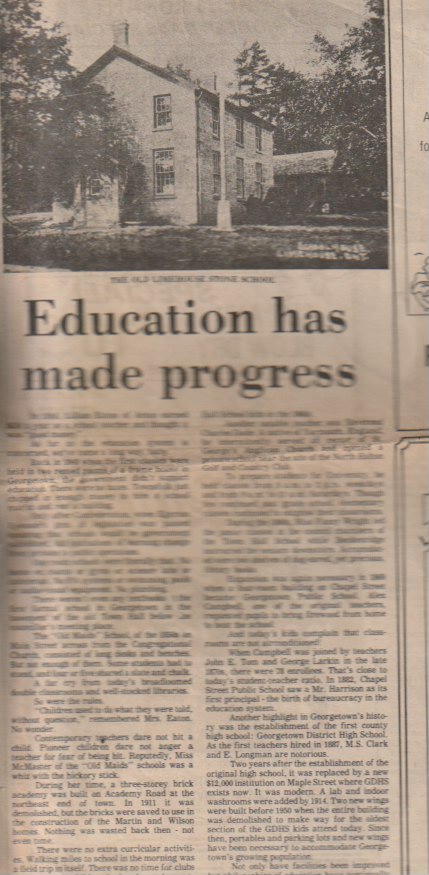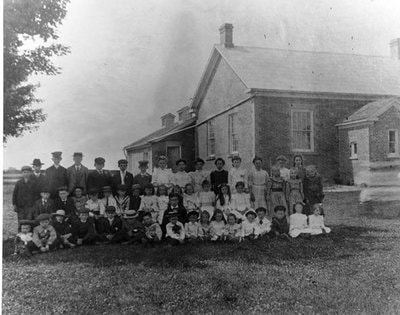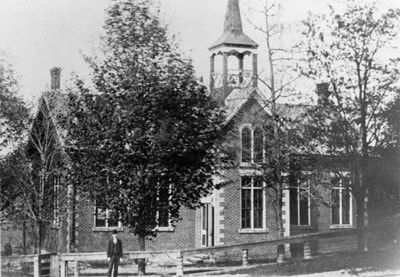Teachers and Schools
In 1916, Lillian Eaton of Acton earned $650 a year as a school teacher and thought it was “good money”.
As far as the education system is concerned, we’ve come a long wat, baby.
Back in 1848 when the first classes were held in two rented rooms of a frame house in Georgetown, the government didn’t support education. There were no taxes. Townsfolk just mar’m and rent a building. Only after Confederation, when Egerton Ryerson’s gem of legislation was passed ensuring that schools would be government subsidized, did institutions of learning change from private to public operations. One room schools were literally that. No home ec rooms or gyms or science labs or cafeterias. No PA systems or swimming pools or audio-visual. No plumbing. There weren’t even any textbooks at the first formal school in Georgetown in the basement of the old town hall below the councillor’s meeting place.
The “Old Maids” School of the 1850’s on Main Street across from the Congregational Church, consisted of long desks and benches. But not enough of them. Some students had to stand, and four or five shared a slate and chalk.
A far cry from today’s broadloomed double classrooms and well=stocked libraries.
So were the rules “Children used to do what they were told without question.” Remembered Mrs. Eaton. No wonder. Contemporary teachers dare not hit a child. Pioneer children dare not anger a teacher for fear of being hit. Reputedly, Miss McMaster of the “Old Maids” schools was a whiz with the hickory stick. During her time, a three-storey brick academy was built on Academy Road at the northeast end of town. In 1911 it was demolished, but the bricks were saved to use in the construction of the Martin and Wilson homes. Nothing was wasted back them – not even time.
There were no extra curricular activities, walking miles to school in the morning was a field trip in itself. There was no time for clubs after classes, children had to hurry home to help with chores. The only recreational part of the basic “3R” curriculum was singing. Remembered as a music buff, James Beckenridge taught choral singing to Town Hall Schools kids in the 1860’s.
Another notable teacher was Reverend Charles Dade. A native of Yarmouth, England, he intermittently served as rector of St. George’s Anglican Church and opened a private school near the site of the North Halton Golf and Country Club.
To prepare students for University, he held classes from 9am to 2pm, Weekdays and from 9am to 11am Saturdays. Though few continued past grade school, elementary classes continued to outgrow their classrooms. During the 1860’s, Miss Fanny Wright led junior classes in the council chambers of the Town Hall School while Beckenridge instructed the seniors downstairs.
Accumulated were two shelves of dog-eared, yet precious, library books.
Expansion was again necessary in 1869 when a four-room building on Chapel Street became Georgetown Public School. Alex Campbell, one of the original teachers, requested pupils to bring firewood from home to heat the school. And today’s kids complain that classesrooms are not airconditioned! When Campbell was joined by teachers John E. Tom and George Larkin in the late 1870’s, there were 78 enrollees. That’s close today’s student-teacher ratio. In 1882, Chapel Street Public School saw a Mr. Harrison as its first principal – the birth of bureaucracy in the education system. Another highlight in Georgetown’s history was the establishment of the first county high school: Georgetown District High School. As the first teachers hired in 1887, M.S. Clark and E. Longman are notorious. Two years after the establishment of the original high school, it was replaced by a new $12,000 institution on Maple Street where GDHS exits now. It was modern. A lab and indoor washrooms were added by 1914. Two new wings were built before 1950 when the entire building was demolished to make way for the oldest section of the GDHS kids attend today. Since then portables and parking lots and new wings have been necessary to accommodate Georgetown’s growing population. Not only have facilities been improved but philosophies of education have continually needed revision to update the system in step with the changing times. Yes, with co-ed baseball and home ec, we’ve come a long way baby.
My thoughts, Wow I think we have come along way since this was written. With equal rights, with Every child matters and so on. This is history we don't change the facts, we don't rewrite, we recall and learn from the past, and embrace the past too, some are things are wonderful in the past. Be thankful for what was built for our future generations.
Dave Bennett
As far as the education system is concerned, we’ve come a long wat, baby.
Back in 1848 when the first classes were held in two rented rooms of a frame house in Georgetown, the government didn’t support education. There were no taxes. Townsfolk just mar’m and rent a building. Only after Confederation, when Egerton Ryerson’s gem of legislation was passed ensuring that schools would be government subsidized, did institutions of learning change from private to public operations. One room schools were literally that. No home ec rooms or gyms or science labs or cafeterias. No PA systems or swimming pools or audio-visual. No plumbing. There weren’t even any textbooks at the first formal school in Georgetown in the basement of the old town hall below the councillor’s meeting place.
The “Old Maids” School of the 1850’s on Main Street across from the Congregational Church, consisted of long desks and benches. But not enough of them. Some students had to stand, and four or five shared a slate and chalk.
A far cry from today’s broadloomed double classrooms and well=stocked libraries.
So were the rules “Children used to do what they were told without question.” Remembered Mrs. Eaton. No wonder. Contemporary teachers dare not hit a child. Pioneer children dare not anger a teacher for fear of being hit. Reputedly, Miss McMaster of the “Old Maids” schools was a whiz with the hickory stick. During her time, a three-storey brick academy was built on Academy Road at the northeast end of town. In 1911 it was demolished, but the bricks were saved to use in the construction of the Martin and Wilson homes. Nothing was wasted back them – not even time.
There were no extra curricular activities, walking miles to school in the morning was a field trip in itself. There was no time for clubs after classes, children had to hurry home to help with chores. The only recreational part of the basic “3R” curriculum was singing. Remembered as a music buff, James Beckenridge taught choral singing to Town Hall Schools kids in the 1860’s.
Another notable teacher was Reverend Charles Dade. A native of Yarmouth, England, he intermittently served as rector of St. George’s Anglican Church and opened a private school near the site of the North Halton Golf and Country Club.
To prepare students for University, he held classes from 9am to 2pm, Weekdays and from 9am to 11am Saturdays. Though few continued past grade school, elementary classes continued to outgrow their classrooms. During the 1860’s, Miss Fanny Wright led junior classes in the council chambers of the Town Hall School while Beckenridge instructed the seniors downstairs.
Accumulated were two shelves of dog-eared, yet precious, library books.
Expansion was again necessary in 1869 when a four-room building on Chapel Street became Georgetown Public School. Alex Campbell, one of the original teachers, requested pupils to bring firewood from home to heat the school. And today’s kids complain that classesrooms are not airconditioned! When Campbell was joined by teachers John E. Tom and George Larkin in the late 1870’s, there were 78 enrollees. That’s close today’s student-teacher ratio. In 1882, Chapel Street Public School saw a Mr. Harrison as its first principal – the birth of bureaucracy in the education system. Another highlight in Georgetown’s history was the establishment of the first county high school: Georgetown District High School. As the first teachers hired in 1887, M.S. Clark and E. Longman are notorious. Two years after the establishment of the original high school, it was replaced by a new $12,000 institution on Maple Street where GDHS exits now. It was modern. A lab and indoor washrooms were added by 1914. Two new wings were built before 1950 when the entire building was demolished to make way for the oldest section of the GDHS kids attend today. Since then portables and parking lots and new wings have been necessary to accommodate Georgetown’s growing population. Not only have facilities been improved but philosophies of education have continually needed revision to update the system in step with the changing times. Yes, with co-ed baseball and home ec, we’ve come a long way baby.
My thoughts, Wow I think we have come along way since this was written. With equal rights, with Every child matters and so on. This is history we don't change the facts, we don't rewrite, we recall and learn from the past, and embrace the past too, some are things are wonderful in the past. Be thankful for what was built for our future generations.
Dave Bennett






